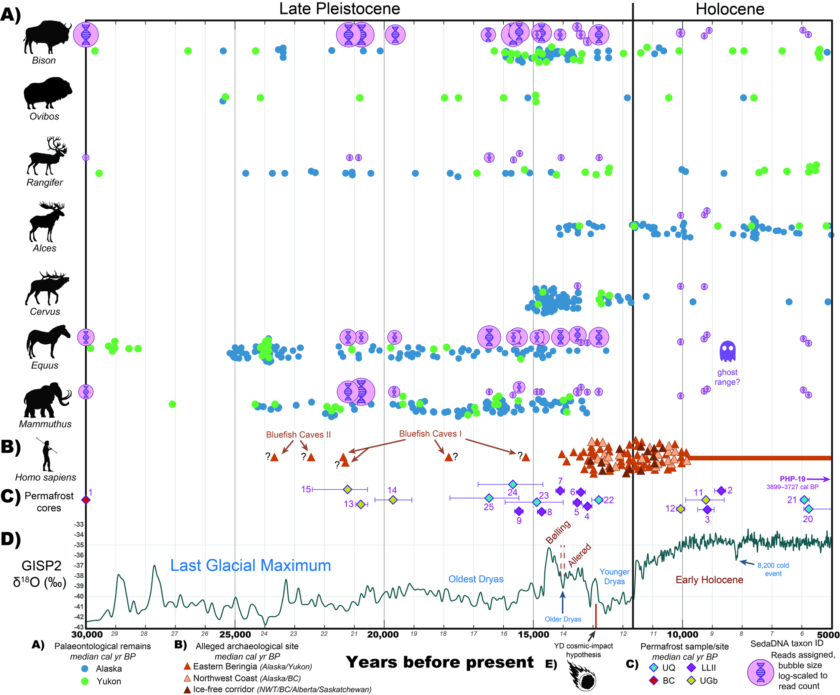
It is now possible to obtain ancient DNA. Is that a cue for the Jurassic Park theme tune?
Nope, not that far back.
What it does do is open a window into the Pleistocene.
But wait, the half life of DNA is about 521 years, so how is this actually possible?
We will come to that shortly. First, I need to introduce you to eDNA.
Environmental DNA
Life leaves bits of itself behind – poo, skin, etc. If you take samples of water or dirt then you will be able to isolate and decode this environmental DNA (eDNA). That can then be matched against a DNA database to see what you have got from your sample. This is becoming an increasingly powerful scientific tool for two reasons …
- The cost of sequencing DNA continues to rapidly drop.
- The DNA Databases are rapidly growing
Yes, lots of different DNA is all mixed up within any sample, so what you do is to use DNA metabarcoding and then do an automated lookup within a DNA library. For example BLAST (basic local alignment search tool) is an example of a way to do this.
The beauty of this approach is that you can in effect take a complete snapshot of an entire ecosystem. The value this brings is that you gain extremely valuable insights that are not practically possible via any other means.
Hey, you could use this to hunt for the Lock Ness Monster

Yes, indeed you can.
Exactly that was done a couple of years ago. Professor Neil Gemmell of the University of Otago, New Zealand gathered up roughly about 250 water samples, then took them back to his lab.
Hunting the Lock Ness Monster! Is this guy a crank?
Not at all.
When he started down this path in 2017, he was challenged about this and explained it as follows …
Some of my colleagues have said, oh, this is just a bit silly and you’re diverting attention from important questions – why don’t you tell them about the really cool stuff, not this nonsense? And I said, well, you know, I’ll tell them about whatever people are interested in. And I will try to take the conversation in a direction where I can add a bit of knowledge in and around what we do, attached to the idea of something that people actually give a damn about.
In other words, hold a press conference about eDNA and you would be lucky to have anybody turn up. Rock up on the shores of Lock Ness for a monster hunt and you will get a media frenzy. That’s exactly what happened in 2019.
He travelled all the way back to Loch Ness to announce the results when in reality an email would have been just fine. He knew nobody would read it, so the trip became a bit of a media scrum.
The result?
Oh come now, even if you don’t remember that story, you can guess.
No Plesiosaur DNA.
Via the 2019 press release, we learn …
What I’m most satisfied with is that we came here to study environmental DNA, and our analysis has captured everything we thought is in the loch. We now have an excellent database which if compared to any future testing could enable us to identify trends and changes in the Loch environment. That is essentially the benefit of eDNA – it is an extremely powerful and robust tool to document the living things (both large and microscopic) present in a given place. It’s going to be extremely useful in the future as the technology becomes quicker and more accessible, more data is created.”
Professor Gemmell says one of the more intriguing findings was the strong input of DNA from land-based species in the Loch.
“We found substantial levels of DNA from humans and a variety of species directly associated with us such as dogs, sheep and cattle. However we also detected wild species local to the area such as deer, badgers, foxes, rabbits, voles and multiple bird species. These findings indicate eDNA surveys of major waterways may be useful for rapidly surveying biological diversity at a regional level.”
Sorry folks, no monster. This is a rather conclusive result.
I can however predict that the monster myth will live on. The Scottish tourist board and many locals who need visitors will ensure that happens.
Let’s move on.
Mining Ancient eDNA
Back in September 2020, a team of researchers developed a new technique to extract, isolate, sequence and identify tiny fragments of ancient DNA from sediment.
Back to that half-life of 521 years for DNA. If it is all on ice and frozen then you can go far further back. It means that you can still find fragments from tens of thousands of years ago from permafrost cores.
The lead author of the DNA recovery paper, Tyler J. Murchie, has written a posting that appeared recently within SciTechDaily and lays it all out.
Titled “Ancient DNA Suggests Woolly Mammoths Roamed the Earth More Recently Than Thought”, it explains how they used this ancient eDNA recovery from the permafrost to in effect open a window into the past and see what was actually once there within that environment.
There is of course a new paper with all the latest results. That was published Jan 10, 2022, within “Current Biology” and is titled “Pleistocene mitogenomes reconstructed from the environmental DNA of permafrost sediments”. (That’s an open Access paper, no paywall there, but be warned, it is very technical).
Combine the new eDNA insights with what we already know via bones and archeology, and what you get is a picture that looks like this …

What did they discover?
What was already known was that there was a Pleistocene-Holocene transition, which occurred about 11,700 years ago.
Huge changes took place. In eastern Beringia (the former Eurasian land bridge and unglaciated regions of Yukon and Alaska), this period saw the collapse of the mammoth-steppe biome and its gradual replacement with the boreal forest as we know it today.
What the new eDNA results bring to the table is this …
We were also able to observe how ecosystems shifted with the rise of woody shrubs around 13,500 years ago, and how that correlated with a decline of DNA from woolly mammoths, horses and steppe bison. With this remarkably rich dataset, we observed four main findings.
- There was a surprising consistency in the signal between sites, suggesting our data was representative of ecological trends in the region.
- Woolly mammoth DNA declines prior to the Bølling–Allerød warming, a warm period at the end of the last ice age, suggesting that megafaunal losses may have been staggered.
- Forbs (herbaceous flowering plants) make up a substantial component of the mammoth-steppe ecosystem alongside grasses.
- There is a consistent signal of woolly mammoth and Yukon horse persistence into the Holocene, as much as 7,000 years after their disappearance from fossil records.
In other words, the woolly mammoths were still roaming about long after we thought they were gone.
Yea but what does it all mean?
Horses and woolly mammoths may have been around in the Klondike until roughly 9,000 years ago and perhaps as recently as 5,700 years ago. That’s a lot more recent than previously thought.
But wait, fossilised bones are not this recent, so appropriate caution is needed.
One answer is that the eDNA could also have been eroded and then re-deposited, hence they recognise they might be getting mixed signals. However, it is also worth noting that fossilisation is a rare event. As the numbers decrease, the probability of a fossil being preserved rapidly shrinks. The eDNA data is not the only evidence of this. Tyler does also make these points …
studies have now shown that mammoths survived until 5,500 and 4,000 years ago on Arctic islands.
Researchers at the Centre for GeoGenetics in Copenhagen found evidence for the late survival of horses and mammoths in Alaska until as recently as as 7,900 years ago. They also found evidence of mammoths surviving as recently as 3,900 years ago in Siberia, alongside woolly rhinoceros to at least 9,800 years ago.
In other words, what the eDNA reveals is very credible.
There is a dawning realisation, a distinct probability, that these rather large chunky beasts that we assumed had died out in a far more distant past had actually lived on in the north. In other words while we were building the pyramids they were still there.
This is almost the plot of “The Land that Time Forgot”.
Gathering eDNA Fossils opens a window that is fast closing
Permafrost is an ideal way for these eDNA fossils to be preserved.
The development of a means to process this ancient eDNA has opened a window that enables us to see what was really out there.
The catch is that we are also about to lose this opportunity.
Global warming.
The permafrost is melting, and as it does so, all the ancient eDNA is being lost.
One last unexpected Plot twist
If we can get these ancient DNA fragments and piece them together, then can we bring these ancient animals back?
Yes, that sounds like science fiction, but somebody is actually having a go at this. Harvard University geneticist Prof George Church announced several years ago that he and his team are close to making a mammoth-elephant hybrid. They have been reconstructing mammoth DNA from frozen remains.
One day you really might be able to go visit Pleistocene Park.
No T-Rex, just mammoths.
Further Reading
- Tyler’s article laying out the detail – Ancient DNA Suggests Woolly Mammoths Roamed the Earth More Recently Than Thought
- Open Access Paper published within Current Biology – Pleistocene mitogenomes reconstructed from the environmental DNA of permafrost sediments
